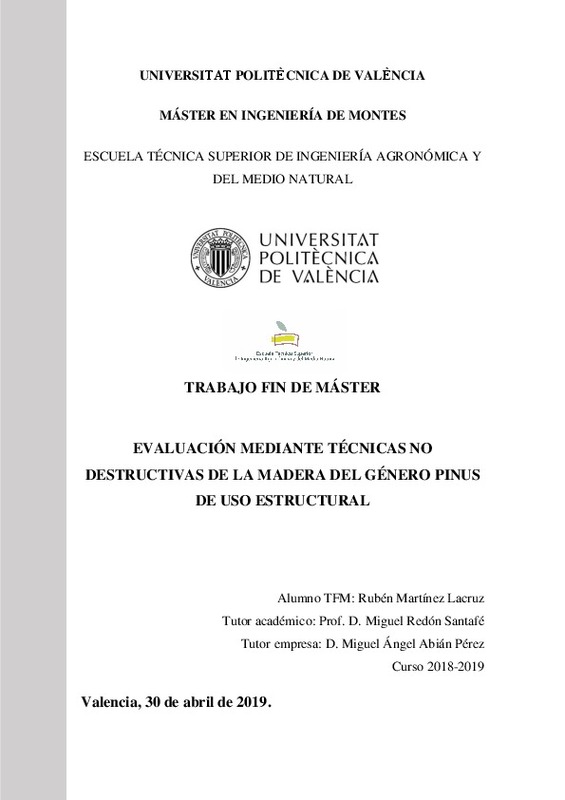JavaScript is disabled for your browser. Some features of this site may not work without it.
Buscar en RiuNet
Listar
Mi cuenta
Estadísticas
Ayuda RiuNet
Admin. UPV
Evaluación mediante técnicas no destructivas de la madera del género pinus de uso estructural
Mostrar el registro sencillo del ítem
Ficheros en el ítem
| dc.contributor.advisor | Redón Santafé, Miguel
|
es_ES |
| dc.contributor.advisor | Abian Perez, Miguel Angel
|
es_ES |
| dc.contributor.author | Martínez Lacruz, Rubén
|
es_ES |
| dc.date.accessioned | 2020-05-07T14:18:21Z | |
| dc.date.available | 2020-05-07T14:18:21Z | |
| dc.date.created | 2019-05-16 | |
| dc.date.issued | 2020-05-07 | es_ES |
| dc.identifier.uri | http://hdl.handle.net/10251/142754 | |
| dc.description.abstract | [ES] La madera se ha utilizado históricamente y se utiliza como material estructural en numerosas edificaciones y estructuras, como forjados, cerchas, postes de luz, traviesas de ferrocarril, etc. Debido a su origen biológico, es habitual que presente defectos como nudos, bolsas de resina, fendas, desviaciones de la fibra, etc., que ocasionan disminuciones de su resistencia mecánica y dificultan su clasificación estructural. Esto hace que muchas veces, por desconocimiento de su resistencia exacta, la madera no se utilice como material de construcción o de ingeniería. Durante las últimas décadas se han realizado numerosas investigaciones centradas en determinar las propiedades mecánicas de la madera estructural mediante técnicas de evaluación no destructivas (TND). Si bien se han conseguido importantes avances en ese campo de investigación, se necesita contar con una evaluación que incorpore las mejoras recientes en algunas TND, como la resistografía, y que sea también más fiable y precisa que las actuales. El objetivo de la presente investigación consiste en desarrollar una metodología que permita clasificar estructuralmente mediante TND madera estructural del género Pinus, incluyendo la mejora reciente en la técnica de resistografía, así como otros parámetros característicos de la madera de interés (número de nudos, proporción albura/duramen, etc.). La investigación se desarrolla en las instalaciones y laboratorios de AIDIMME (Instituto Tecnológico Metalmecánico, Mueble, Madera, Embalaje y Afines), y cuenta con la colaboración de su Departamento de Tecnología y Biotecnología de la Madera. Para determinar la eficacia de la metodología y la precisión de los resultados, estos se comparan estadísticamente con los resultados obtenidos mediante ensayos de flexión hasta rotura según norma UNE-EN 408:2011+A1, que son los utilizados para clasificar la madera según el sistema de clases resistentes del Código Técnico de la Edificación (CTE). | es_ES |
| dc.description.abstract | [EN] Wood has been used historically and is used as a structural material in many buildings and structures, such as floors, trusses, light poles, etc. Due to its biological origin, it is common to present defects such as knots, bags of resin, fissures, deviations from fiber, etc., which cause decreases in their mechanical resistance and make their structural classification difficult. This means that many times, due to lack of knowledge of its exact strength, the wood is not used as a construction or engineering material. During the last decades there have been numerous investigations focused on determining the mechanical properties of structural wood by means of non- destructive evaluation techniques (NDT). Although important advances have been made in this field of research, an evaluation is needed that incorporates the recent improvements in some NDTs, such as resistography, and that is also more reliable and accurate than the current ones. The objective of this research is to develop a methodology that structurally classifies structural wood of the Pinus genus through NDT, including the recent improvement in the resistography technique, as well as other parameters characteristic of the wood of interest (number of knots, albura / heartwood, etc.). The research is carried out in the facilities and laboratories of AIDIMME (Metal-Mechanical Technological Institute, Furniture, Wood, Packaging and Related Products) and has the collaboration of its Department of Wood Technology and Biotechnology. To determine the effectiveness of the methodology and the precision of its results, these are compared statistically with the results obtained by bending tests until breaking according to the UNE-EN 408:2011 standard, which are used to classify wood according to the system of resistant classes of the Technical Building Code (CTE). | es_ES |
| dc.format.extent | 379 | es_ES |
| dc.language | Español | es_ES |
| dc.publisher | Universitat Politècnica de València | es_ES |
| dc.rights | Reconocimiento - No comercial (by-nc) | es_ES |
| dc.subject | Madera estructural | es_ES |
| dc.subject | Ensayos (Tecnología) | es_ES |
| dc.subject | Ensayos no destructivos | es_ES |
| dc.subject | Ensayos por ultrasonidos | es_ES |
| dc.subject | Resistencia de materiales | es_ES |
| dc.subject | Resistografía | es_ES |
| dc.subject | Structural wood | es_ES |
| dc.subject | Testing | es_ES |
| dc.subject | Non-destructive testing | es_ES |
| dc.subject | Strenght of materials | es_ES |
| dc.subject | Ultrasonic testing | es_ES |
| dc.subject | Resistography | es_ES |
| dc.subject.classification | INGENIERIA AGROFORESTAL | es_ES |
| dc.subject.other | Máster Universitario en Ingeniería de Montes-Màster Universitari en Enginyeria de Forests | es_ES |
| dc.title | Evaluación mediante técnicas no destructivas de la madera del género pinus de uso estructural | es_ES |
| dc.type | Tesis de máster | es_ES |
| dc.rights.accessRights | Abierto | es_ES |
| dc.contributor.affiliation | Universitat Politècnica de València. Departamento de Ingeniería Rural y Agroalimentaria - Departament d'Enginyeria Rural i Agroalimentària | es_ES |
| dc.contributor.affiliation | Universitat Politècnica de València. Escuela Técnica Superior de Ingeniería Agronómica y del Medio Natural - Escola Tècnica Superior d'Enginyeria Agronòmica i del Medi Natural | es_ES |
| dc.description.bibliographicCitation | Martínez Lacruz, R. (2019). Evaluación mediante técnicas no destructivas de la madera del género pinus de uso estructural. http://hdl.handle.net/10251/142754 | es_ES |
| dc.description.accrualMethod | TFGM | es_ES |
| dc.relation.pasarela | TFGM\101856 | es_ES |
Este ítem aparece en la(s) siguiente(s) colección(ones)
-
ETSIAMN - Trabajos académicos [3541]
Escuela Técnica Superior de Ingeniería Agronómica y del Medio Natural






